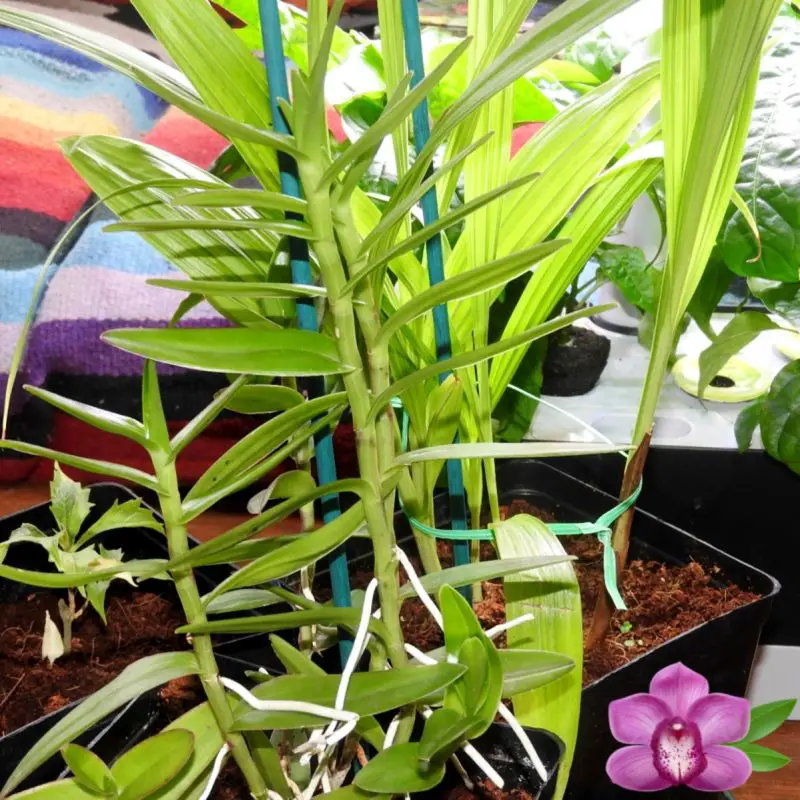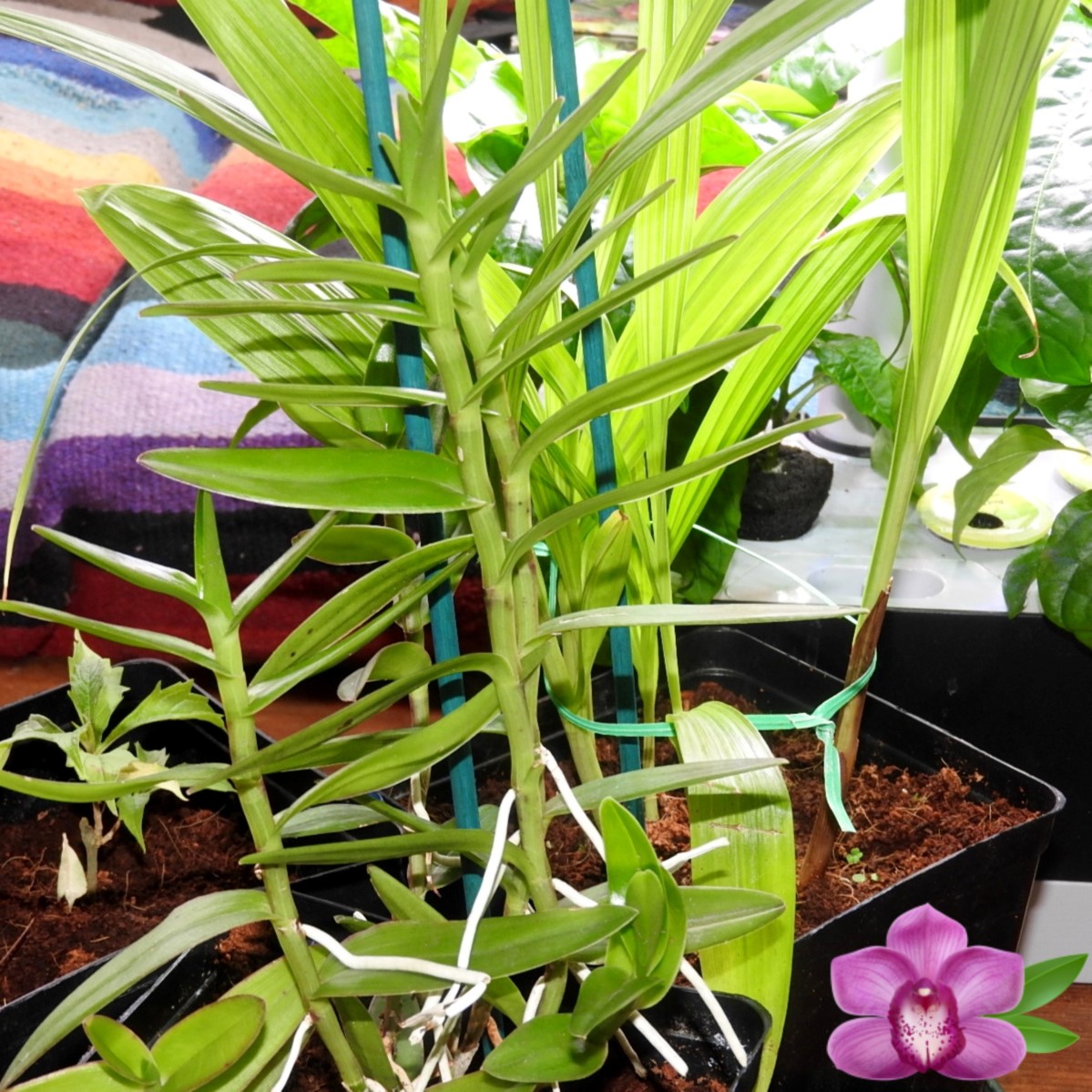
Are orchids hard to take care of? Orchids have a reputation for being finicky and hard to grow but is this really true? You can find out here.
Are Orchids Hard To Take Care Of?
Orchids are not really that hard to grow and make excellent houseplants. But you need to give them what they need.
There are thousands of orchid species and just like dealing with people, some are much easier to get along with than others.
If you look at the flowers at any supermarket you will undoubtedly see orchids for sale at a very affordable price.
So these are being grown commercially and in large numbers so can they really be that hard to grow?
The secret to growing orchids or any other plant is just figuring out what they need to grow well and giving it to them.
How To Care For Orchids In The House
I have grown everything from artichokes to zucchini and can truthfully say no plants are hard to grow if you give them what they need.
This can be a challenge in an outdoor garden where we have little control over temperatures or the length of our growing season.
Since we are talking about how to care for orchids in the house we have a chance to provide the right environment to grow orchids.
So it is true orchids are a bit different than some other plants but let’s take a look at where they grow and the conditions they thrive under.
Learn how to care for Encyclia Orchids
Where Do Orchids Grow And How?
There are thousands of orchid species but they fall into 2 basic types. There are epiphytes or epiphytic orchids. There are terrestrial orchids.
Epiphytic Orchids
Most commonly grown orchids are epiphytes and are sometimes called air plants.
They grow on trees or in branch crotches. They have specialized roots that get water and nutrients from the air.
They are commonly found in tropical rainforests. This should help give us clues as to what these plants need.
What kind of climate do epiphytic orchids live in?
- They grow primarily in tropical areas where day and night are 12 hours each
- So we now know orchids prefer warm temperatures.
- Orchids prefer bright but indirect light
- They grow in areas with high humidity
- There are frequent rain showers
- There is good airflow and breezes in these areas
- The roots go through wet and dry cycles naturally
With this in mind, we can provide the proper growing conditions for our orchids to thrive.
So the first thing we need to know is orchids don’t need or want direct sunlight. In fact, too much sun can be harmful.
So this makes orchids a good houseplant for an apartment where we might struggle to get enough light for many other plants.
Although orchids prefer warm temperatures they don’t like extremes. Temperatures in the 75-85° range are perfect with 65- 75° at night.
They are shaded where they grow so temperatures are warm during the day and cool down at night.
Most apartments will be good temperature-wise unless they are kept very cool but even here there will be warmer spots to place them.
Orchids like fairly high humidity so if it is dry in your house you can mist them or place them in a terrarium. Orchid Terrarium DIY [An Unusual Fish Tank Transformation] – Hydroponic Orchids
If your house is air-conditioned it will remove humidity as it cools the air. This can lower humidity drastically as can home heating so you could consider running a humidifier.
What Soil Do Orchids Grow In?
Epiphytic orchids do not grow in soil at all. They grow by anchoring themselves to tree bark or moss.
When you buy an orchid it will probably be in moss or a moss/bark mix. You can buy orchid potting mix to replant your orchid.
Orchids don’t mind being somewhat rootbound but if you decide to repot your orchid you will want a slightly larger pot.
It is even possible to grow orchids in water but there is a bit more to it than just dropping them in water. Can Orchids Grow In Water? Surprising Answer – Hydroponic Orchids
Probably there is more information on orchid growing media than anything else and much of it is conflicting.
The #1 Trick To Growing Orchids
The trick to growing orchids is keeping roots moist but not wet. In the wild orchid roots are wet by rains but airflow can dry them out again by the end of the day.
The closer you can come to providing the proper balance of wetness and dryness combined with good humidity the better your orchids will grow.
That is where all the fuss over growing mediums for orchids stems from.
This might seem daunting but often the answer can be as simple as misting the aerial roots every day or two.
Growing Terrestrial Orchids
So far we have talked about epiphytic orchids because they are the most commonly available.
But terrestrial orchids are often overlooked which is a shame because in many ways they are much easier to grow.
Terrestrial orchids grow in the tropics on the forest floor. But there are hardy terrestrial orchids that even grow in alpine meadows.
So this is a very varied group of plants. They can have pretty flowers and fantastic fragrances just like their epiphytic cousins.
Some can be grown outdoors year-round in mild winter areas. They can even be grown in light potting soil or in coco coir. Growing Terrestrial Orchids [Grow These Easy Orchids] – Hydroponic Orchids
How Long Do Orchids Live?
Orchids are renowned for their longevity, often outliving the very pots they’re grown in.
When cultivated indoors with proper care, orchids typically grace our homes with their presence for 10 to 15 years, although some enthusiasts have nurtured their plants for over 20 years!
The orchid’s lifespan can be maximized by providing a stable environment that mimics their natural habitat, which includes ensuring they receive the right amount of light, water, and humidity.
The key to an orchid’s longevity lies in its care.
Phalaenopsis Orchids
Phalaenopsis orchids, a favorite among beginners due to their hardiness and beautiful blooms, thrive in steady indoor conditions with moderate temperatures and indirect sunlight.
They require more frequent watering during their active growing periods, particularly in the summer, but be cautious not to overdo it as overwatering can lead to diseases like root rot.
In terms of temperature, Phalaenopsis orchids prefer a range between 65-80°F, with a slight drop at night.
Dendrobium Orchids
Dendrobium orchids, another popular variety, share similar care requirements but can often handle a bit more light.
They also follow a distinct growth cycle with blooming typically occurring between February and June, followed by a growth phase and then a dormant stage, which is essential for the next cycle of flowering.
Hybrid Orchids: A World of Colorful Possibilities
Hybrid orchids represent the exciting intersection of nature and human creativity.
By combining the genetic material of different orchid species or genera, horticulturists have developed a dazzling array of hybrids that boast unique colors, patterns, and forms.
These man-made wonders are not only a testament to the artistry of breeding but also offer enhanced resilience and adaptability, making them a popular choice for both novice and experienced growers.
Types of Hybrid Orchids
Primary Hybrids: These are created by crossing two different species within the same genus. They often combine the best traits of both parent species, resulting in new and interesting varieties.
Complex Hybrids: These involve crossing two or more primary hybrids or species. They can exhibit a wide range of characteristics and are often bred for specific traits like flower size, color, or fragrance.
Intergeneric Hybrids: These are created by crossing species from different genera. They can result in some of the most unusual and striking orchids, combining features that are not typically seen in nature.
Advantages of Hybrid Orchids
Variety: Hybridization allows for an almost limitless array of colors, patterns, and shapes, catering to the diverse tastes of orchid enthusiasts.
Vigor: Hybrids often exhibit “hybrid vigor,” meaning they can be more robust, disease-resistant, and adaptable than their purebred counterparts.
Longer Blooming Periods: Many hybrids are bred to have longer blooming periods, providing a more extended display of their stunning flowers.
Popular Hybrid Orchids
Phalaenopsis Hybrids: Known for their long-lasting flowers, these hybrids come in a rainbow of colors and are among the most popular orchids for home growers.
Cattleya Hybrids: Famous for their large, fragrant blooms, Cattleya hybrids are often used in corsages and are highly sought after by collectors.
Dendrobium Hybrids: These are known for their prolific blooming and wide range of colors. They are relatively easy to care for, making them great for beginners.
Read about: Oncostele Orchid Care
Caring for Hybrid Orchids
While care requirements can vary depending on the specific hybrid, some general tips include providing ample indirect light, maintaining moderate humidity, and watering when the potting medium is dry.
Regular feeding with a balanced orchid fertilizer during the growing season will also help ensure vibrant blooms.
In conclusion, hybrid orchids offer a fascinating and beautiful way to explore the diversity of the orchid family.
With their wide range of appearances and characteristics, there’s a hybrid orchid to suit almost any taste or growing condition.
Care Tips
To foster growth and blooms, it’s advisable to use a gentle orchid fertilizer and adjust your watering schedule according to the plant’s needs.
While it’s important to maintain moisture, it’s equally important to let the soil dry out slightly between waterings.
Orchids also benefit from high humidity levels, which can be achieved by using a humidity tray, and they should be kept away from direct sunlight and drafts which can harm the delicate flowers.
When considering the plant’s lifespan, it’s interesting to note that orchids begin their journey quite early—often, the orchids you find for sale are already several years old.
As they mature, providing the right conditions for growth becomes even more crucial.
With all these factors in place, orchids can bloom beautifully year after year, each bloom lasting several weeks to a few months, depending on the variety.
Learn about how to care for Jewel Orchids.
Learn about Types of Vanda Orchids
In summary, with the right care and attention, orchids can be a long-term companion in your indoor garden, offering a living testament to the beauty and resilience of nature right in your living room
Are Orchids Hard To Take Care Of? Final Thoughts
Orchids are not hard to take care of. They are a bit different than some houseplants and have a few unique needs that are easy to meet. They need bright but indirect sunlight, good humidity, and light but more frequent watering or misting.
Here is a more scientific look at orchids.Orchidaceae – Wikipedia The more you know the better you can grow.
Here is a good basic article from HomeDepot no less! How to Care for Orchids
This post contains affiliate links.


